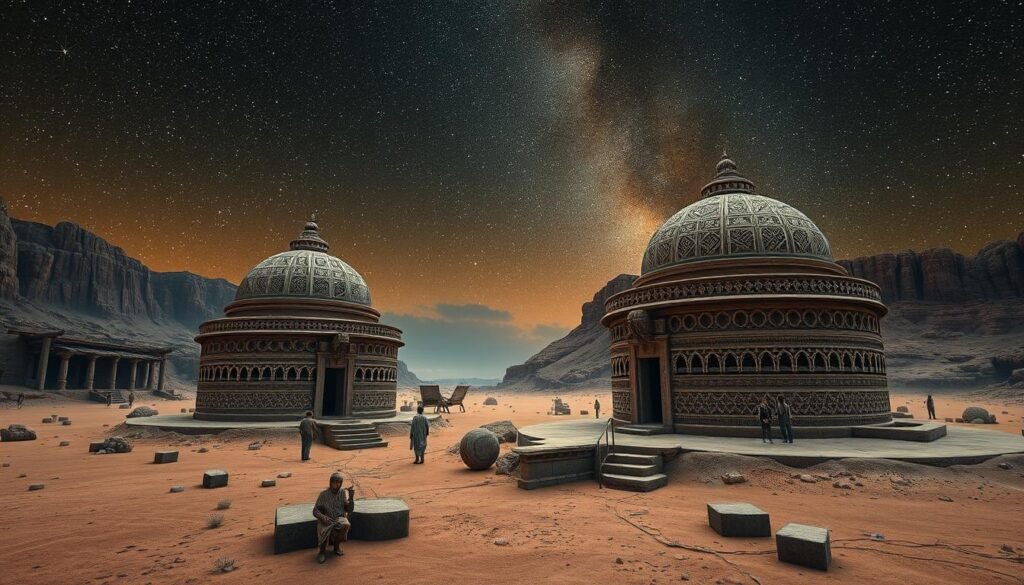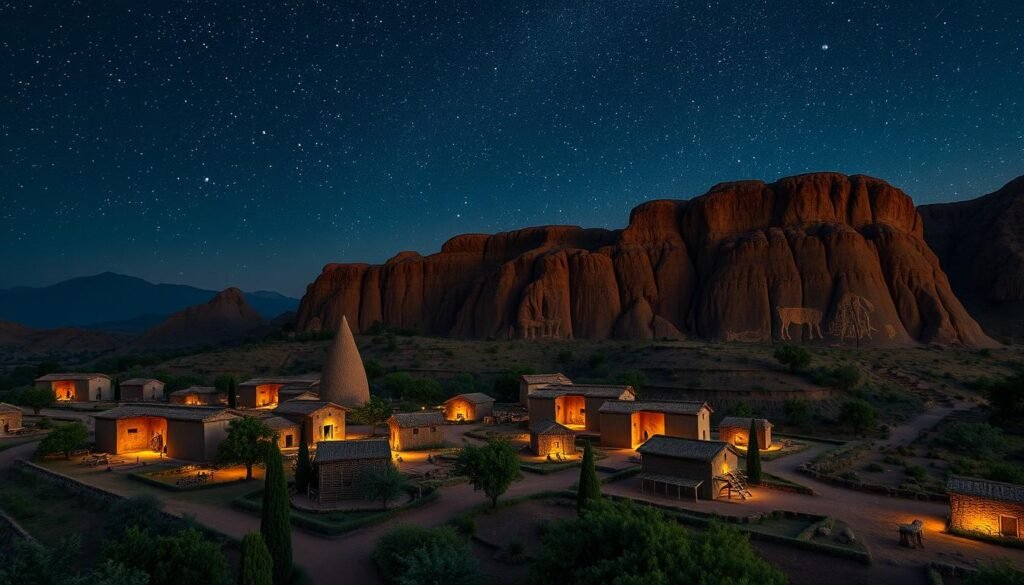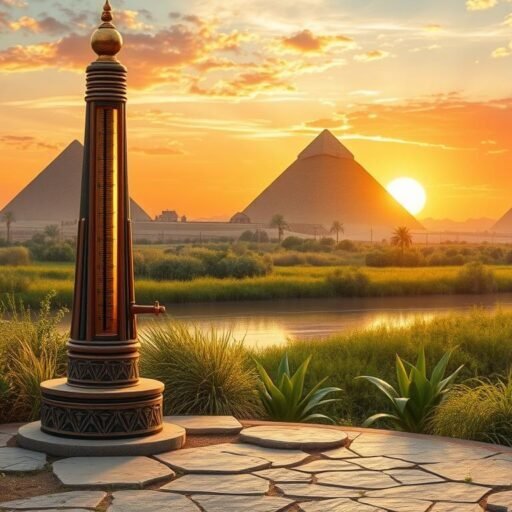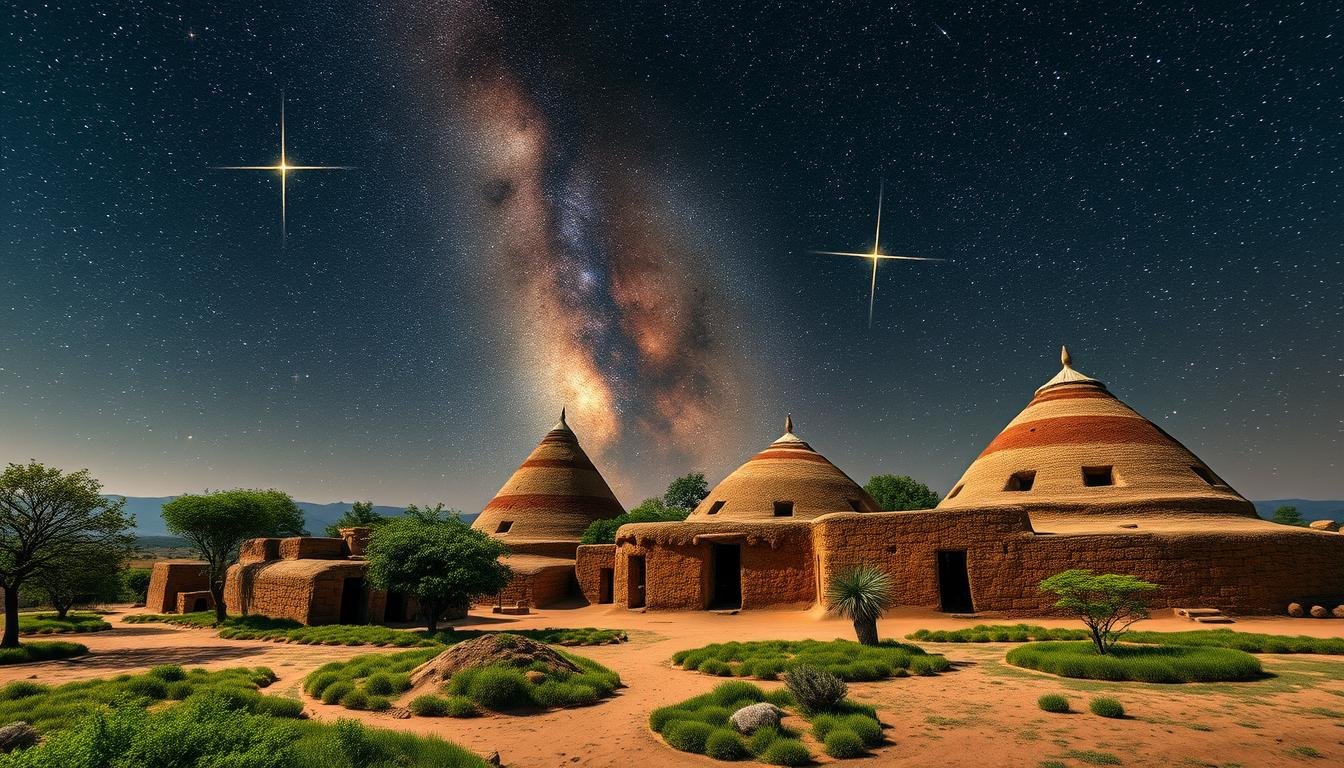The Dogon, an ancient African tribe from Mali, have amazed the world with their deep knowledge of the stars. They understood the Sirius star system in a way that has puzzled scholars and astronomers. Their wisdom about the stars has been passed down for generations.
This knowledge gives us a peek into their rich cultural history and advanced astronomical skills. It shows us how they observed and interpreted the stars. This knowledge greatly influenced their agriculture, seasonal predictions, and cultural rituals.
Key Takeaways
- The Dogon people possess an ancient and profound understanding of the celestial bodies, particularly the Sirius star system.
- Their traditional beliefs and practices are deeply rooted in the observation and interpretation of the stars, influencing their agriculture, seasonal predictions, and cultural rituals.
- The Dogon’s astronomical knowledge has been meticulously preserved through oral history, offering a glimpse into a sophisticated ancient African civilization.
- Scholars and scientists continue to study the Dogon’s celestial wisdom, seeking to unravel the mysteries and connections between their culture and astrology.
- The Dogon’s legacy represents the rich tradition of African astronomy and the enduring human quest to understand the cosmos.
Origins of the Dogon People and Their Celestial Knowledge
The Dogon people live in the Bandiagara Escarpment in Mali, West Africa. They have a rich cultural heritage. Their ancestors settled in this area, keeping their knowledge of the stars for many generations.
Geographic Location and Cultural Background
The Dogon people call the Bandiagara Escarpment home. This area is a 150-kilometer limestone cliff in Mali. It has shaped their culture and their connection to the universe.
Traditional Beliefs and Practices
The Dogon people deeply respect the stars. They use star maps and navigation to understand the sky. These skills help them with farming and predicting seasons.
Oral History Preservation
The Dogon keep their knowledge alive through stories. These stories have been passed down for ages. They protect their heritage, keeping their wisdom safe.
“The Dogon people’s profound understanding of the cosmos is a testament to their rich cultural heritage and their deep connection to the land they inhabit.”
The Sirius Star System in Dogon Cosmology
The Dogon people of West Africa have always been fascinated by the Sirius star system. It’s at the heart of their beliefs and practices. Their deep understanding of Sirius A and Sirius B has amazed scholars and astronomers.
The Dogon believe the Sirius system is home to the Nommo, powerful amphibious deities. They brought knowledge and wisdom to the Dogon. The Dogon knew about Sirius B, a dim white dwarf, long before modern astronomy discovered it in the 1930s.
The Dogon’s love for the Sirius system shows in their star worship. They have rituals, dances, and symbols for it. They see Sirius as the source of all life and the Nommo as creators of the universe.
The Dogon’s knowledge of the stars has sparked debate about their possible contact with extraterrestrial beings. The mystery of their knowledge is still unsolved. Yet, their reverence for Sirius A and Sirius B shows the lasting impact of these stars on their culture and beliefs.
| Dogon Knowledge | Modern Astronomy |
|---|---|
| Sirius B is a small, dense star that orbits Sirius A | Sirius B is a white dwarf star, the second-closest stellar companion to Earth after the Sun’s own companion, Alpha Centauri B |
| Sirius B has a 50-year orbital period around Sirius A | Sirius B has a 50-year orbital period around Sirius A |
| Sirius B is extremely dense, with a mass comparable to that of the Sun | Sirius B has a mass approximately equal to that of the Sun, but is only slightly larger than the Earth |
The Dogon’s deep connection to the Sirius system is a key part of their star worship and Dogon astronomy. The mystery of how they gained this knowledge continues to intrigue scholars and fans. The Sirius system remains a central part of Dogon cosmology.
DOGON AND ASTROLOGY: Ancient Wisdom Revealed
The Dogon people of West Africa are known for their deep knowledge of the stars. They use star maps, navigation, and astronomy for planning and farming. This knowledge has been passed down for generations.
Star Mapping Techniques
The Dogon are experts at mapping the stars. They have detailed charts that track the Sirius star system and more. These maps help them navigate the night sky with great accuracy.
Celestial Navigation Methods
The Dogon also excel in navigation. They use the stars to find their way, time, and season. This skill is key for farming and rituals.
Seasonal Predictions and Agriculture
The Dogon’s knowledge goes beyond just maps and navigation. They understand the seasons and use this to plan farming. This has helped them farm efficiently for years.
| Astronomical Tools | Star Charts | Agricultural Calendar |
|---|---|---|
| Dogon have developed sophisticated astronomical tools to observe and record celestial movements. | Their intricate star charts document the positions and trajectories of celestial bodies, including the Sirius star system. | Dogon use their astronomical knowledge to predict seasonal patterns and plan their agricultural activities accordingly. |
The Dogon’s ancient wisdom is fascinating to many. Their deep connection to the stars shows their culture’s ingenuity and strength.
Sacred Symbols and Astronomical Alignments
The Dogon people of West Africa are known for their deep understanding of the stars. This is shown in their sacred symbols and buildings. These symbols represent their knowledge of the universe and its rhythms.
The Nommo is a key Dogon symbol. It’s a mythical creature that brought knowledge of Sirius to the Dogon. This symbol is found in their art, textiles, and ritual objects, showing their connection to the sky.
The Dogon’s buildings are also special. Their villages and sacred sites follow the stars and planets. For example, the village of Sanga is designed like the sky. Their houses and buildings match the stars’ positions.
- Dogon symbols serve as celestial representations, reflecting their deep knowledge of the cosmos
- The Nommo is a iconic Dogon symbol, representing their mythical connection to the Sirius star system
- Dogon architectural structures are aligned with the movements of the stars and planets, mirroring the celestial patterns
| Dogon Symbol | Celestial Representation | Architectural Alignment |
|---|---|---|
| Nommo | Sirius star system | Village of Sanga |
| Lozenge | Orion constellation | Dogon granaries |
| Spiral | Galaxy formation | Ritual sites |
The Dogon’s deep understanding of the stars shows their rich heritage. Their symbols and buildings reflect this knowledge. These secrets continue to fascinate people, showing the Dogon’s ancient wisdom.
The Mystery of Nommo: Celestial Beings and Star Knowledge
The Dogon people of West Africa believe in the Nommo, a race from the Sirius star system. These beings are key in Dogon Nommo mythology. They share deep, secret knowledge of the stars.
Origin Stories of the Nommo
The Dogon say the Nommo came to Earth as one being, then split into male and female. These amphibious beings taught the Dogon about the universe. They even knew about Sirius B, discovered by science much later.
Connection to Sirius B
The Dogon know a lot about Sirius, including its binary nature and Sirius B. This Sirius folklore is believed to come from the Nommo. They are thought to be from Sirius.
Cultural Significance Today
The Nommo are still important in Dogon culture. They are honored in rituals and ceremonies. Their legacy shows the Dogon’s love for the universe and their ancient wisdom.
“The Nommo are the source of all life and knowledge, and they continue to guide the Dogon people in their understanding of the universe.”
Ancient Observatories and Ritual Sites
The Dogon people of Mali are known for their deep knowledge of astronomy. They built amazing structures that align with the stars. These ancient observatories and ritual sites show their deep understanding of the heavens.
Their buildings, known as Dogon architecture, have astronomical monuments. These were used to watch the stars, moon, and planets. Places like the Sirius temples and the Orion shrines were built to track the sky and honor the stars.
The Sirius temple is a key example. It’s aligned with the star Sirius, the brightest in the sky. Its design shows the Dogon’s deep knowledge of Sirius and its importance in their culture.
The Orion shrines are shaped like triangles and align with Orion. They were important for the Dogon’s seasonal planning and rituals. These sites were where elders watched the sky and interpreted its signs for their community.
There are many other astronomical monuments in Dogon architecture. Each one connects the Dogon to the universe. These sites remind us of the Dogon’s love for the stars and their quest to understand the cosmos.

Modern Scientific Validation of Dogon Knowledge
The Dogon people, from West Africa, have always fascinated scholars and scientists. New discoveries in astrophysics, anthropology, and ethnography have shown that their ancient wisdom is true. This has given their knowledge of the stars and the universe a big boost.
Astronomical Discoveries
The Dogon knew a lot about the Sirius star system. They even knew about Sirius B, a white dwarf star that was unknown to science until later. Today, we know they were right all along.
Archaeological Evidence
Archaeologists have found proof of the Dogon’s advanced knowledge of the stars. They’ve found ancient sites and tools that show they understood the movements of the stars. This proves their deep understanding of the universe.
Scientific Studies and Research
- Many scientific studies have looked into the Dogon’s traditions and beliefs. They’ve found many similarities with modern astrophysical and anthropological ideas.
- Researchers have studied the Dogon’s ways of mapping the stars and predicting seasons. These show they knew a lot about the universe.
- The Dogon’s symbols and how they align with the stars have also been studied. This has shown their ancient knowledge is real.
The Dogon’s wisdom is still important today. It shows how much we can learn from the past. It also shows our connection to the universe is deep and timeless.
| Field of Study | Key Findings |
|---|---|
| Astrophysics | Confirmation of Dogon’s knowledge of Sirius B, the white dwarf companion to the Sirius star system. |
| Anthropology | Exploration of Dogon’s sophisticated star mapping techniques, celestial navigation methods, and seasonal predictions related to agriculture. |
| Ethnography | Investigation of Dogon’s sacred symbols and astronomical alignments, validating their ancient knowledge. |
Cultural Impact and Legacy
The Dogon people’s knowledge of the stars has greatly influenced astronomy and anthropology. Their detailed star maps and oral traditions have amazed scholars everywhere. They have uncovered ancient secrets of the universe.
The Dogon’s efforts to preserve their culture are impressive. Local communities work hard to keep their star knowledge alive. They pass it down to future generations, keeping their cosmic insights alive.
Also, the Dogon’s legacy has sparked scientific interest. Studies have confirmed their deep understanding of the universe. This mix of old wisdom and new science has opened up new areas for research and teamwork.
Today, the Dogon’s star knowledge still fascinates people globally. Their lasting impact shows the wisdom and strength of this West African civilization.
“The Dogon’s astronomical knowledge is a testament to the ingenuity and resilience of their culture, and a reminder of the wealth of knowledge that can be found in ancient traditions.”
| Dogon Influence | Cultural Preservation | Astronomical Heritage |
|---|---|---|
| Captivating scholars and researchers worldwide | Local communities maintain the integrity of their ancestral teachings | Dogon’s sophisticated understanding of celestial bodies validated by modern science |
| Sparked scientific interest and validation | Passing down crucial knowledge from generation to generation | Enduring influence and inspiration worldwide |

Conclusion
The Dogon people’s ancient wisdom has amazed many, showing a deep understanding of the universe before modern science. We’ve looked into their deep knowledge of the stars, its roots, and why it’s still important today.
Their ways of mapping the stars and navigating the sky are fascinating. They also have sacred symbols and places that match the stars. This shows how deep their ancient wisdom is.
Their stories of the Nommo, beings from the Sirius star system, are especially intriguing. This shows the Dogon’s astronomical heritage is both complex and rich.
As we finish our exploration, it’s clear the Dogon’s cosmic knowledge is still valuable today. Their cultural significance goes beyond just astronomy. It shows the lasting power of traditional knowledge and the need to keep diverse cultures alive.
By learning from the Dogon, we gain a new respect for the universe and our shared quest to understand it. Their insights remind us of the beauty and mystery of the cosmos.

